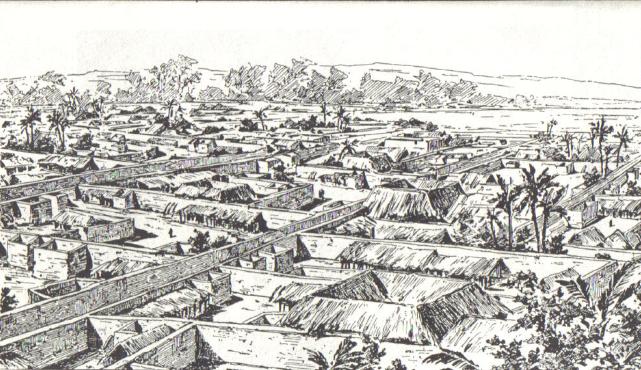You’ve heard of the Great Wall of China, right? The 21,000-km wall was built from 700BC to protect the Imperial China state from attacks by invaders, as well as control of immigration and emigration.
You might’ve possibly heard of the Berlin Wall too, right? Also known as The Iron Curtain, it was a concrete barrier built in 1961 to separate West Berlin from East Berlin during the Cold War. The primary intention of the wall was to prevent citizens of Eastern Germany from fleeing to Western Germany. At this particular period in time, Eastern Germany was a communist state under Soviet influence, while Western Germany was a capitalist state under the influence of the Allies.
You might’ve also heard of the Trump Wall, right? Built by former US President Donald Trump in 2018. The wall, built along the border between USA and Mexico, spans 732km. It was constructed solely to prevent Mexican immigrants from sneaking into the USA.
If you’re into architecture, you might have heard of the Great Wall of WA. Located in Australia, this is a 230 m-long rammed-earth wall that meanders along the edge of a sand dune and contains twelve earth-covered residencies constructed to provide short-term accommodation for a cattle station when they finally gather. It is an impressive feat of architecture, mainly because it seems buried, with the sand dune forming its roof.
Thus far, we have discussed great walls in all the continents (Asia, Europe, the Americas and Australasia). The question remains whether there exists one in Africa. Do you know of any?
Riddle Time
The Benin Kingdom
In the ancient Benin Kingdom, the villages and wards each had ramparts (artificial slopes that have been designed to become walls) and moats (wide trenches around these ramparts that have been filled with water). The purposes of these moats were to signify different socio-political organizations, as well as an act of defence.
Once a set of Ogiso Kings took over the reign of the Kingdom, and seeing the effectiveness of the moats as a form of defence, they decided to adopt them for the whole Kingdom. In 800AD, thus, one major moat was constructed around the whole kingdom.
It started with the construction of a moat and wall around Benin City itself. Then, the earthwork that had been excavated to create room for the inner moat in Benin City, was shipped to the edge of the Kingdom and used to construct the outer wall of the city.
This outer wall of the city was so huge. It was 20m high, spanning a length of 16,000km, and enclosing an area of 6,500 km2. Its size placed it as the second-most extensive earthwork in the whole of human history, second only to the Great Wall of China, which as we said above, is 21,000 km. We, however, cannot verify whether The Great Wall of Benin, too, can be seen from the moon.
The wall was finally completed around 1460 AD. It is important to note that it was constructed purely through manual labour, seeing that it was constructed before the advent of earth-moving machinery.
When it was finally complete, it ended up being a marvellous defensive line. This is because, any invader who wanted to get into the city, first, had a high likelihood of sinking in the sand ramparts that were outside the city. If they didn’t sink, they had to swim across the moat, where they risked drowning. If they didn’t drown, they had to climb up the tall towering wall, where they risked being targeted by Benin soldiers who were armed with spears and poisoned arrows. Inside the wall, again, was another moat. All these barricades made it impossible for invaders to get into the Kingdom.
Access to the kingdom was only through the main nine gates around the city wall. Once you got in, you had to pay a toll. This toll ensured the safety of the kingdom by subjecting all the visitors to security checks.
These visitors to the kingdom were all fascinated by the immense size and security of the wall, as well as the kingdom itself.
Lourenco Pinto, the captain of a Portuguese ship, landed in the Benin Kingdom in 1691, and had this to say: “Great Benin, where the King resides, is larger than Lisbon. All the streets run straight and as far as the eyes can see. The houses are large, especially that of the king which is richly decorated and has Fine columns. The city is wealthy and industrious. It is so well governed that theft is unknown and the people live in such Security that they have no door to their houses.”

Image: Benin Kingdom, a drawing of Benin City made by an English officer. Source: Wikimedia Commons
In his account, 17th-century Dutch visitor Olfert Dapper wrote, “Houses are built alongside the streets in good order, the one close to the other. Adorned with gables and steps … they are usually broad with long galleries inside, especially so in the case of the houses of the nobility, and divided into many rooms which are separated by walls made of red clay, very well erected.”
Clearly, the Portuguese and the Dutch were cool with the wall and kingdom, but the British weren’t.
It all started in 1892, when the British arrived in the area just after the Scramble & Partition of Africa. The Deputy Commissioner of the Royal Niger Company, Captain Galway, negotiated a trade agreement with the leader of the Benin Kingdom, the Oba, to allow the development of the palm-oil industry in his territory.
The Oba was hesitant to sign the treaty, insisting that the British would have to pay tolls in order to access his territory. The British deemed this denial as a hostile act. Ralph Moor, the first high commissioner of the British Southern Nigeria Protectorate, urged the British to use force, if need be, to secure the signed treaty.
In March 1896, the Oba suddenly called for the cessation of the supply of palm oil to the British. This brought trade in the region to a standstill. The merchants were angered by that action, and so, they planned a ‘visit’ to Benin.
In 1897, Sir Henry Rawson led a group of 1,200 men on a punitive expedition to invade and capture the Kingdom of Benin. The ensuing battle took 29 days, and eight members of the British expedition died. On the other hand, the casualties on the Benin side were so high that they could not even be estimated.
The houses, sacred sites, ceremonial buildings and palaces were looted and burned down. The artworks, famously known today as the Benin Bronzes, were shipped off to Britain. They included thousands of metal plaques and sculptures.
The British occupied Benin and absorbed it into the British Niger Coast Protectorate, which eventually became the British Colony of Nigeria. As a result, the huge Benin Wall had to go down, bringing to an end the 1000-year-old Iron Curtain.
Special Mentions
📌 Benin Kingdom (Civilisations) Part 1 & Part 2 - Afriwetu
📌 A General History of Iron Technology in Africa ca. 2000BC-1900AD. - African History Extra
New Language Learning Resources
Join the Lughayangu Community!


